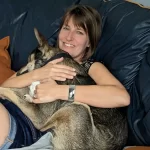Gwendolyn Calhoon

Assistant in Instruction
Associations
Program in Neuroscience
Hathorn Hall 108
About
I have always been fascinated that the nervous system produces everything we experience, think, feel, and do. That the activity of a biological system results in the intangible elements of our lived experience made me want to know more! As the AI for Neuroscience here at Bates, I am delighted that I get to help foster this enthusiasm for learning about the brain in our students!
I earned my undergraduate degree in Psychology from St. Mary’s College of Maryland, where I cultivated an interest in the neurobiological underpinnings of psychiatric illnesses like schizophrenia. Following a gap year as a research technician, I did my PhD work at the University of MD, Baltimore. There, I developed skills in rodent behavior and intracellular electrophysiology to assess how individual cells in the nucleus accumbens (a brain region important for reward learning and motivated behavior) respond to converging, competing signals from upstream brain regions. I completed a postdoctoral fellowship at Massachusetts Institute of Technology, where I studied the interconnections between two complementary populations of neurons in the amygdala that oppositely encode emotional valence, and how the interaction between these populations changes dynamically in satiety versus hunger. My main scientific interests are in how neurons interact in small- and large-scale circuits to drive motivation and emotion. I am also particularly interested in how these circuits are influenced by what and whether we eat.
A Selection of Relevant Prior Work
- Publication: Calhoon, G. G., Sutton, A. K., Chang, C.-J., Libster, A. M., Glober, G. F., Leveque, C. L., Murphy, G. D., Namburi, P., Leppla, C. A., Siciliano, C. A., Wildes, C. P., Kimchi, E. Y., Beyeler, A., & Tye, K. M. (2018). Acute food deprivation rapidly modifies valence-coding microcircuits in the amygdala. bioRxiv, doi: 10.1101/285189. Link: https://www.biorxiv.org/content/10.1101/285189v1
- Publication (explaining our published work to kids!): Calhoon, G. G. & Tye, K. M. (2018). Getting emotional: How the amygdala learns the difference between good and bad. Frontiers for Young Minds, 6: 69. Link: https://kids.frontiersin.org/articles/10.3389/frym.2018.00069/full
- Publication: Calhoon, G. G. & Tye, K. M. (2015). Resolving the neural circuits of anxiety. Nature Neuroscience, 18 (10): 1394-1404. Link: https://www.nature.com/articles/nn.4101
- Publication: Calhoon, G. G. & O’Donnell, P. (2013). Closing the gate in the limbic striatum: prefrontal suppression of hippocampal and thalamic inputs. Neuron, 78 (1): 181-90. Link: https://www.cell.com/neuron/fulltext/S0896-6273(13)00098-6
- Publication: Gruber, A. J., Calhoon, G. G., Shusterman, I., Schoenbaum, G., Roesch, M. R., & O’Donnell, P. (2010). More is less: A disinhibited prefrontal cortex impairs cognitive flexibility. The Journal of Neuroscience, 30 (50): 17102-17110. Link: https://www.jneurosci.org/content/30/50/17102